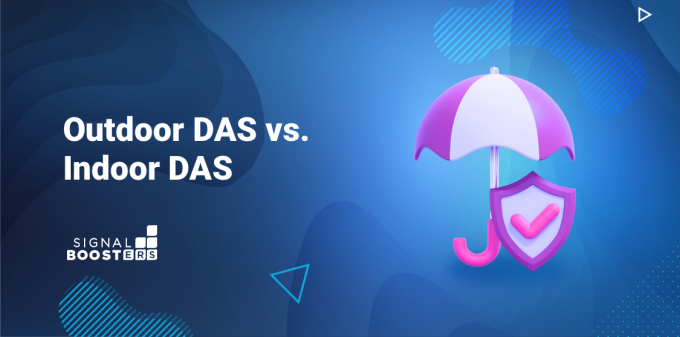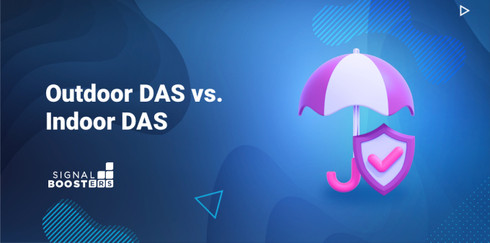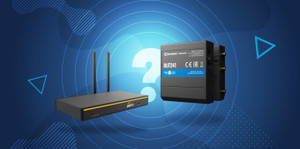Outdoor DAS (oDAS) vs Indoor DAS (iDAS) Cell Signal Anywhere

If you know cell phone signal boosters, you know they are limited to in-building use. To cover a large outdoor area with reliable cell signal, your best option is an Outdoor DAS (oDAS).
A DAS (Distributed Antenna System) is a network of spatially separated antenna nodes connected to a common source. A transport medium (usually fiber cable) provides wireless service within a geographic area or structure. In plain English, it is a method of providing reliable radio or cellular signal to a fixed area. This allows these areas or buildings to get reliable coverage without the need for a dedicated cell tower serving them.
If you're looking to have a DAS, whether oDAS or iDAS, installed on your premises, contact us. We provide nationwide DAS installation and have helped numerous companies like yours rid themselves of cellular problems permanently.
Contact UsIf you're looking for more information, read on.
Take advantage of our system design and installation services. Learn more or call us for a free consultation: 1-800-969-8189.
There are several types of DAS, for numerous use cases. We will focus on Outdoor DAS (oDAS) and Indoor DAS (iDAS) in this article.
How a DAS Works
A DAS has two basic components:
- Signal Source: DAS cannot generate signal. They receive signal one of three ways: over-the-air from a cellular tower, via an on-site base transmission station, or through small cells.
- Distribution System: The signal, whether 5G or 4G LTE, needs to be distributed somehow. There are four main methods. Active DAS uses direct cabling. Passive DAS uses antenna networks in building. Hybrid mixes both methods. Digital uses new tech – more on this later.
We have mentioned Outdoor DAS (oDAS) already, but there is also the more-common Indoor DAS (iDAS). For more on Active, Hybrid, or Passive DAS, see our comprehensive DAS guide. For more on Public Safety DAS and ERRCS, see our Public Safety and ERRCS options.
Outdoor DAS (oDAS)
Benefits
Outdoor DAS is one of the only methods to cover high-density outdoor venues. Parks, open-roofed stadiums, courtyards, pools, resorts, campuses, and more benefit from Outdoor DAS. A well-deployed system can eliminate dropped calls and bad reception, not only improving quality of life but allowing for rapid response during emergencies.
Outdoor DAS can be used for 5G and 4G LTE across all cellular bands and for any carrier. A reliable Outdoor DAS uses Active DAS, meaning cellular carriers must give permission. This avoids potential complications within the overall cellular network.
Crucially, Outdoor DAS can be deployed across Public Safety and ERRCS bands as well. Many base stations can handle numerous bands at once, providing total coverage to an area.
Costs and Technology
Deploying an Outdoor DAS used to be one of the most expensive, time-consuming projects in wireless. However, due to the proliferation of new technology such as Digital DAS, it is now more feasible than ever.
Outdoor DAS uses remote radio heads (RRHs) to propagate cell signal. These connect to a large base station by fiber cable. These base stations are somewhere between a small cell and a cell tower in terms of signal generated. They require a great deal of power. RRHs typicallly have 1, 5, or even 20 Watt RF power output. These RRH nodes are housed in weather-proof outdoor enclosures and placed in public areas to enhance cellular coverage.
If multiple carrier coverage is desired, multiple base stations are necessary.
Now, Digital DAS has made Outdoor DAS more practical and affordable by eliminating the need for headend equipment. Instead, the remote units are connected directly to the base station.
Still, despite these advancements, oDAS deployment remains time-consuming and difficult, especially compared to iDAS. Carrier signoff is necessary for any Active DAS system, and the cost of materials is generally higher than Indoor DAS.
Indoor DAS (iDAS)
Indoor DAS (or iDAS) is, by far, the most common type of DAS deployment. This is due to a couple factors. First, it is generally less expensive than oDAS, with Passive and Hybrid options coming in at a significantly lower cost than Active DAS. Second, buildings suffer from worse cell signal than outdoor areas due to building materials killing cell reception. These factors mean building owners are more likely to arrange for an iDAS deployment.
Depending on the size of the building and the type of deployment, engineers will divide the coverage area needs into sectors. iBwave system design services provide accurate propagation maps by overlaying proposed equipment over existing floor plans. This allows for precise placement of remote units (RUs), usually dome or panel antennas.
Signal Boosters has turnkey Passive iDAS deployment options available.
Differences Between Outdoor and Indoor DAS
The primary difference between Outdoor and Indoor DAS is the technology used. Indoor DAS is cheaper and easier to deploy in nearly all situations. It has more options for deployment, with Active and Passive systems as viable options in most scenarios.
Outdoor DAS requires the use of remote radio heads (RRHs) as opposed to Indoor DAS and its remote units (RUs). RRHs use higher power than RUs. That said, in many areas an Outdoor DAS are the best option. The only other method for outdoor coverage is a cell tower macrocell. These are entirely under carrier discretion and have difficulty handling large influxes of people at a time.
Interested in oDAS or iDAS? Contact Us!
Signal Boosters is a leading provider of cell phone signal boosters for homes, vehicles, and commercial buildings. We specialize in consumer-friendly kits as well as customized RF systems for cellular, public safety two-way radio, DAS, and WiFi.
We’re here to assist with any issues you might be experiencing with poor cell service. Contact us today, or call us at 1-800-470-6777.
Interested in Learning More? Check Out Our Cellular Info Hub / WiFi Info Hub





